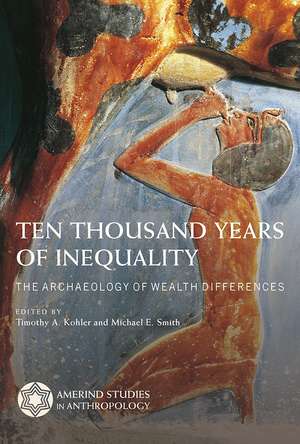Ten Thousand Years of Inequality: The Archaeology of Wealth Differences: Amerind Studies in Archaeology
Editat de Timothy A. Kohler, Michael E. Smithen Limba Engleză Hardback – 16 apr 2018
Is wealth inequality a universal feature of human societies, or did early peoples live an egalitarian existence? How did inequality develop before the modern era? Did inequalities in wealth increase as people settled into a way of life dominated by farming and herding? Why in general do such disparities increase, and how recent are the high levels of wealth inequality now experienced in many developed nations? How can archaeologists tell?
Ten Thousand Years of Inequality addresses these and other questions by presenting the first set of consistent quantitative measurements of ancient wealth inequality. The authors are archaeologists who have adapted the Gini index, a statistical measure of wealth distribution often used by economists to measure contemporary inequality, and applied it to house-size distributions over time and around the world. Clear descriptions of methods and assumptions serve as a model for other archaeologists and historians who want to document past patterns of wealth disparity.
The chapters cover a variety of ancient cases, including early hunter-gatherers, farmer villages, and agrarian states and empires. The final chapter synthesizes and compares the results. Among the new and notable outcomes, the authors report a systematic difference between higher levels of inequality in ancient Old World societies and lower levels in their New World counterparts.
For the first time, archaeology allows humanity’s deep past to provide an account of the early manifestations of wealth inequality around the world.
Contributors
Nicholas Ames
Alleen Betzenhauser
Amy Bogaard
Samuel Bowles
Meredith S. Chesson
Abhijit Dandekar
Timothy J. Dennehy
Robert D. Drennan
Laura J. Ellyson
Deniz Enverova
Ronald K. Faulseit
Gary M. Feinman
Mattia Fochesato
Thomas A. Foor
Vishwas D. Gogte
Timothy A. Kohler
Ian Kuijt
Chapurukha M. Kusimba
Mary-Margaret Murphy
Linda M. Nicholas
Rahul C. Oka
Matthew Pailes
Christian E. Peterson
Anna Marie Prentiss
Michael E. Smith
Elizabeth C. Stone
Amy Styring
Jade Whitlam
Ten Thousand Years of Inequality addresses these and other questions by presenting the first set of consistent quantitative measurements of ancient wealth inequality. The authors are archaeologists who have adapted the Gini index, a statistical measure of wealth distribution often used by economists to measure contemporary inequality, and applied it to house-size distributions over time and around the world. Clear descriptions of methods and assumptions serve as a model for other archaeologists and historians who want to document past patterns of wealth disparity.
The chapters cover a variety of ancient cases, including early hunter-gatherers, farmer villages, and agrarian states and empires. The final chapter synthesizes and compares the results. Among the new and notable outcomes, the authors report a systematic difference between higher levels of inequality in ancient Old World societies and lower levels in their New World counterparts.
For the first time, archaeology allows humanity’s deep past to provide an account of the early manifestations of wealth inequality around the world.
Contributors
Nicholas Ames
Alleen Betzenhauser
Amy Bogaard
Samuel Bowles
Meredith S. Chesson
Abhijit Dandekar
Timothy J. Dennehy
Robert D. Drennan
Laura J. Ellyson
Deniz Enverova
Ronald K. Faulseit
Gary M. Feinman
Mattia Fochesato
Thomas A. Foor
Vishwas D. Gogte
Timothy A. Kohler
Ian Kuijt
Chapurukha M. Kusimba
Mary-Margaret Murphy
Linda M. Nicholas
Rahul C. Oka
Matthew Pailes
Christian E. Peterson
Anna Marie Prentiss
Michael E. Smith
Elizabeth C. Stone
Amy Styring
Jade Whitlam
Preț: 550.22 lei
Preț vechi: 647.31 lei
-15% Nou
Puncte Express: 825
Preț estimativ în valută:
105.30€ • 110.77$ • 87.86£
105.30€ • 110.77$ • 87.86£
Carte indisponibilă temporar
Doresc să fiu notificat când acest titlu va fi disponibil:
Se trimite...
Preluare comenzi: 021 569.72.76
Specificații
ISBN-13: 9780816537747
ISBN-10: 0816537747
Pagini: 352
Ilustrații: 49 b&w illustrations, 25 tables
Dimensiuni: 152 x 229 x 30 mm
Greutate: 0.59 kg
Ediția:1
Editura: University of Arizona Press
Colecția University of Arizona Press
Seria Amerind Studies in Archaeology
ISBN-10: 0816537747
Pagini: 352
Ilustrații: 49 b&w illustrations, 25 tables
Dimensiuni: 152 x 229 x 30 mm
Greutate: 0.59 kg
Ediția:1
Editura: University of Arizona Press
Colecția University of Arizona Press
Seria Amerind Studies in Archaeology
Notă biografică
Timothy A. Kohler is a regents professor of anthropology at Washington State University. His most recent book, edited with Mark D. Varien, is Emergence and Collapse of Early Villages: Models of Central Mesa Verde Archaeology. Michael E. Smith is a professor of archaeology at Arizona State University. His latest book is the prize-winning At Home with the Aztecs: An Archaeologist Uncovers Their Daily Life.
Descriere
Archaeology at last allows the humanity’s deep past to provide an account of the early manifestations of wealth inequality around the world. In this first systematic presentation of quantitative data on ancient inequality, archaeologists explore the nature and implications of wealth disparity in the distant past.











